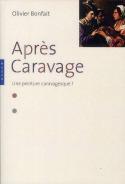Après Caravage
Olivier Bonfait
For nearly a century and in particular following the lobbying carried out by art historian Roberto Longhibetween th two wars, Caravaggio became a sacred star of ancient art. His adventurous life, his iconoclasm (to represent religious scenes with Roman robbers), his mysterious death on a beach in Tuscany had all nourished the myth. Caravaggio is seen today as being at the head of a school and each of his retrospectives is a real succcess. The author signs a bood that is just as iconoclastic: he takes Caravaggio from his pedestal -while expressing his admiration for him - by showing that hte innovations he is admired for, such as the half figures, the scenes placed next to a religious allegory in one same painting are allshared with other artists such as Ribera. In the same manner, his so-called ’school’ does not correspond to a group of students but rather to competitors such as Bartolomeo Manfredi who systemazed his choice for realisms and the chiaro-scuro. The artist was nourished with statistics by going through the major Roman collections of the XVIIth century, describing sequences of real concrete life (Borgianni, Guidotti), of passionate developments on the figure of the bohemian or the theme of the concert, and the reader goes through the book almost lke a police mystery.
|  |
Review published in the newsletter #278 - from 8 November 2012 to 14 November 2012
